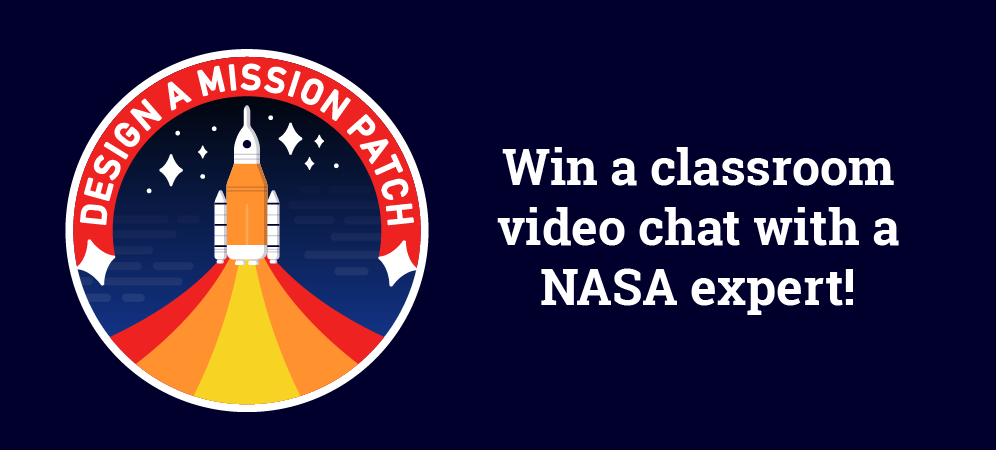
Table of Contents
The Forward to the Moon  Mission Patch Design Challenge
Mission Patch Design Challenge
Calling all innovators! Parents, educators and students: The Tynker team is excited to bring you a wonderful opportunity to participate in a design coding challenge inspired by NASA’s space missions. Since the beginning of time, humankind has had a primordial urge to explore the unknown. Mission after mission, NASA has inspired us with the distances we can go! All these missions have motivated a whole generation of kids who wanted to grow up to be astronauts, engineers and rocket scientists. Software will continue to power human spaceflight in the future, which is why learning about space and learning to code are a perfect combination!
The Program: Moon 2 Mars
NASA is now on an ambitious mission to go Forward to the Moon, stay there, learn, and use what they learn to get humans even farther from the Moon–all the way to Mars! Over the next decade, the plan is to build an open exploration architecture with as many capabilities that can be replicated as possible for missions to Mars.
“NASA is excited by this partnership with Tynker. The challenges use NASA’s bold mission of sending humans to the surface of the Moon within the next 5 years as a context for igniting student interest in coding and STEM. These skills are crucial to developing our future workforce.”
Dr. Bev Girten, Director of Institutional Engagement, NASA
Dr. Girten is enthusiastic about using the #Moon2Mars initiative to inspire the next generation of scientific and technological leaders who will sustain space exploration for years to come.
The Challenge: Design a Mission Patch
The first of these Moon2Mars coding challenges is Design a Mission Patch, which gets students to bring their imagination to human spaceflight as they combine their coding and artistic skills.
After NASA selects a crew for a mission, one of the first jobs of the new crew is to create a mission patch that represents themselves and the mission. Patches often include the astronauts’ names, the vehicle they’re going to pilot, or symbols of their mission. The patches frequently feature colors and shapes that represent key aspects of their mission.
There have been a variety of colors, symbols, and other features on mission patches. Explore these mission patches from the International Space Station and Apollo missions!
The Code: How to Participate and Submit
Encourage your students to learn about human spaceflight with NASA and get creative by making their very own mission patches! The Design a Mission Patch Challenge is a block coding project for students in grades 1-8. Tynker has created a lesson plan, which will be available on your teacher dashboard, to guide you through every step in teaching your students about the patches and helping them create their own. This is a great opportunity for students to explore the history of NASA and develop their creativity skills as they draw pictures of their patches. Then, they can create and animate their patches in Tynker. Make sure they remember to write about their personal inspiration for their patch.
The Design a Mission Patch Challenge project will go live on Monday, April 29th, 2019. Why not use class time till then to get students excited about NASA and space exploration? Have them explore the terrific NASA resources in the project Teacher Guide to start thinking about what their mission patch could represent. Even more resources are listed below.
The Prize: Win a Video Chat with a NASA Expert!
But the fun doesn’t stop at learning about NASA and creating mission patches in Tynker. We’re excited to give your students the opportunity to enter their Tynker mission patches for a chance to win a live video conference with a NASA expert!

Once students have finished creating their moon mission patches, have them publish their project on Tynker by 11:59 p.m. PST on Sunday, May 5th, 2019. Top projects can be seen at the Tynker Moon2Mars Challenge page. NASA and Tynker will judge and select winners.
Conversations with NASA experts will be scheduled for the week of May 19, 2019–the 50th anniversary of the Apollo 10 mission, which was the ‘dress rehearsal’ for Apollo 11, the historic lunar landing mission!
Even More Ways to Bring Space Science to Your Students
Interested in more ways you can learn about NASA and science in your classroom?
- Keep an eye out for more Moon to Mars coding challenges from Tynker in 2019!
- Check out NASA’s new Forward to the Moon Explorer Activities with fun activities for students ages 5-12!
- Visit the NASA STEM Engagement website to find resources for teachers to help make science exciting and meaningful for your students.
- In Tynker’s Space Quest, a coding puzzle for beginning coders, students help the astronaut find a new spaceship! And in Lost in Space for intermediate coders, students help a spaceman named Biff get back home.
- Weave coding curriculum like Tynker’s Physical Science course into your lesson plans, no matter what subject you teach!
Share with your students our Women in STEM blog post about Margaret Hamilton, who helped write the source code for the Apollo 11 mission.




